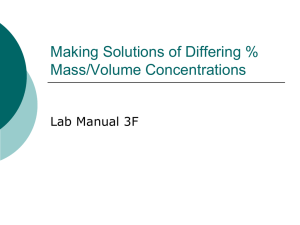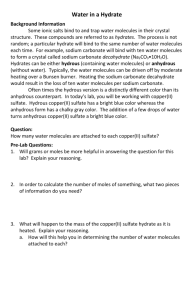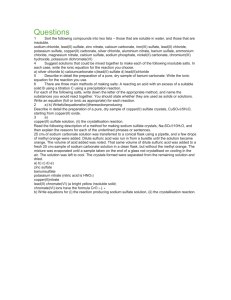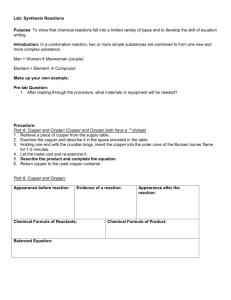Chemist: Identifying Elements by Flame Tests Objectives: Perform
advertisement
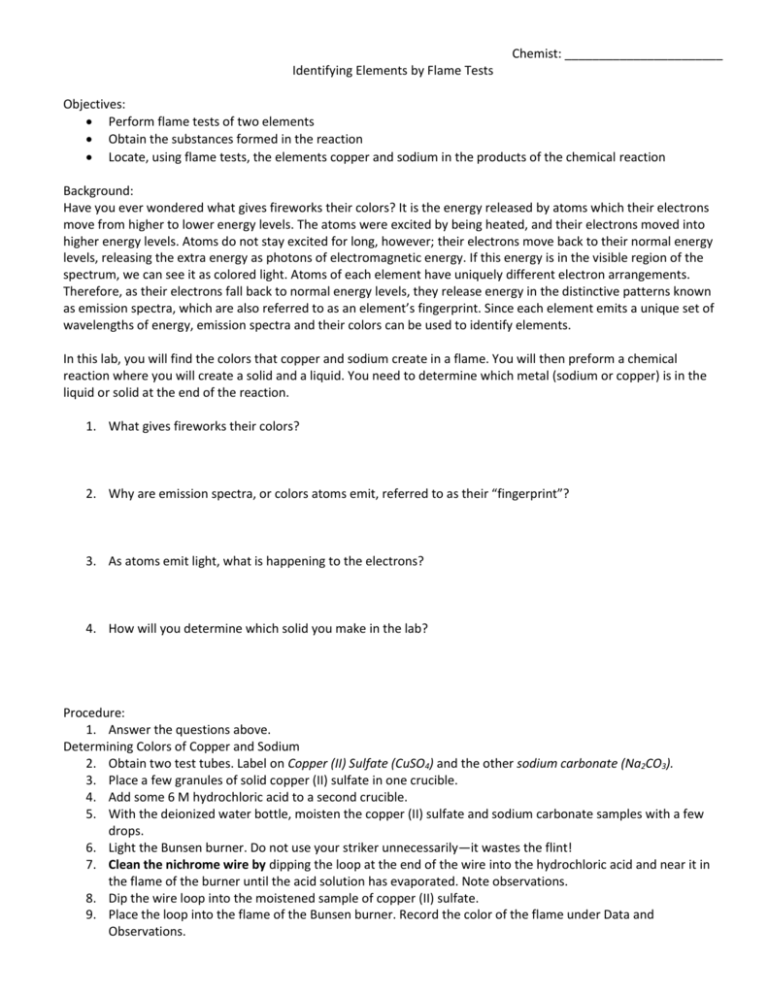
Chemist: _______________________ Identifying Elements by Flame Tests Objectives: Perform flame tests of two elements Obtain the substances formed in the reaction Locate, using flame tests, the elements copper and sodium in the products of the chemical reaction Background: Have you ever wondered what gives fireworks their colors? It is the energy released by atoms which their electrons move from higher to lower energy levels. The atoms were excited by being heated, and their electrons moved into higher energy levels. Atoms do not stay excited for long, however; their electrons move back to their normal energy levels, releasing the extra energy as photons of electromagnetic energy. If this energy is in the visible region of the spectrum, we can see it as colored light. Atoms of each element have uniquely different electron arrangements. Therefore, as their electrons fall back to normal energy levels, they release energy in the distinctive patterns known as emission spectra, which are also referred to as an element’s fingerprint. Since each element emits a unique set of wavelengths of energy, emission spectra and their colors can be used to identify elements. In this lab, you will find the colors that copper and sodium create in a flame. You will then preform a chemical reaction where you will create a solid and a liquid. You need to determine which metal (sodium or copper) is in the liquid or solid at the end of the reaction. 1. What gives fireworks their colors? 2. Why are emission spectra, or colors atoms emit, referred to as their “fingerprint”? 3. As atoms emit light, what is happening to the electrons? 4. How will you determine which solid you make in the lab? Procedure: 1. Answer the questions above. Determining Colors of Copper and Sodium 2. Obtain two test tubes. Label on Copper (II) Sulfate (CuSO4) and the other sodium carbonate (Na2CO3). 3. Place a few granules of solid copper (II) sulfate in one crucible. 4. Add some 6 M hydrochloric acid to a second crucible. 5. With the deionized water bottle, moisten the copper (II) sulfate and sodium carbonate samples with a few drops. 6. Light the Bunsen burner. Do not use your striker unnecessarily—it wastes the flint! 7. Clean the nichrome wire by dipping the loop at the end of the wire into the hydrochloric acid and near it in the flame of the burner until the acid solution has evaporated. Note observations. 8. Dip the wire loop into the moistened sample of copper (II) sulfate. 9. Place the loop into the flame of the Bunsen burner. Record the color of the flame under Data and Observations. 10. 11. 12. 13. 14. 15. 16. 17. 18. 19. 20. 21. 22. Empty the crucible with the copper (II) sulfate down the drain and rinse with deionized water. Place a few granules of sodium carbonate in the rinsed crucible and moisten with deionized water. Repeat steps 7-10. Mass 0.5 grams of copper (II) sulfate and add it to your labeled test tube. Mass 0.75 grams of sodium carbonate and add it to the other labeled test tube. Add exactly 5.0 mL of deionized water to each test tube well to mix. Pour the copper (II) sulfate solution into the sodium carbonate solution. Mix thoroughly. Record observations. Fold a piece of filter paper and set up a filtration system with an evaporating dish underneath. Pour the contents of the test tube into the filter paper and funnel. If necessary, add more deionized water to remove all solid. Don’t add too much—otherwise you will have to wait for it to filter! Place the evaporating dish and the filtrate (liquid) it contains on the hot plate to evaporate. Put a beaker under the funnel. Rise the solid on the filter paper cone three times with deionized water. Discard the rinsed water that drops into the beaker. With the solid in the evaporating dish, repeat steps 7-10. Make sure all group members are watching! Record the color of the flame. With the solid on the filter paper, repeat steps 7-10. Make sure all group members are watching! Record the color of the flame. Discard all waste in the white bucket in the fume hood. Discard any solids in the garbage. Data and Observations: 1. Color of the flame with solid copper (II) sulfate: __________ 2. Color of the flame with solid sodium carbonate: _________ 3. Result of mixing copper (II) sulfate and sodium carbonate solutions: 4. Color of the flame with the solid in the evaporating dish: 5. Color of the flame with the solid from the test tube: Analysis: 1. It is the metals in chemical compounds that give color to the flame when flame tests are done. What are the flame colors for: a. Copper: b. Sodium: 2. When the two solutions are mixed (step 16), did a chemical reaction occur? Give the evidence that supports your answer. 3. Were copper and sodium changed when you mixed the two solutions (step 16)? Give evidence that supports your answer. Conclusions: 1. Describe what happened to the copper from the solid copper (II) sulfate when the copper and sodium salts were dissolved and the two solutions were mixed. What evidence supports your answer? 2. What happened to the sodium from the solid sodium carbonate when the copper and sodium salts were dissolved and the two solutions were mixed? What evidence supports your answer? 3. Was the method you hypothesized (background #4) similar to the procedure you followed to locate copper and sodium after the salt solutions of the metals were mixed? 4. How many protons, neutrons, and electrons do the most common isotopes of sodium and copper have? Sodium: Copper:


